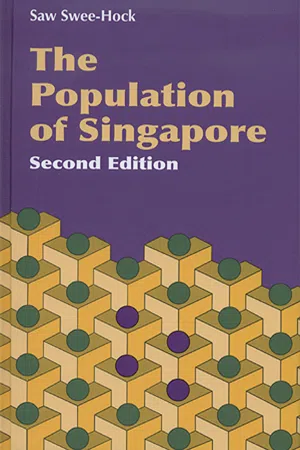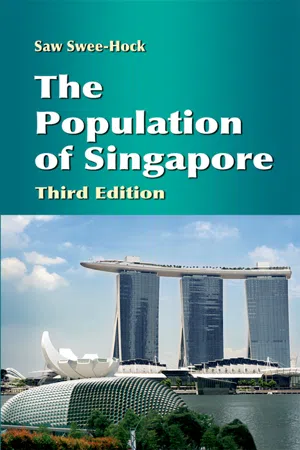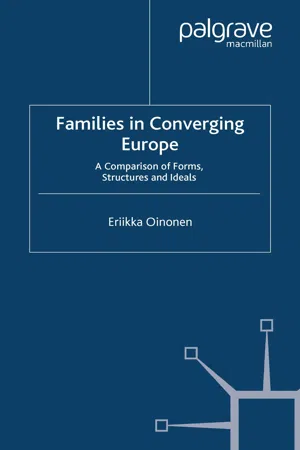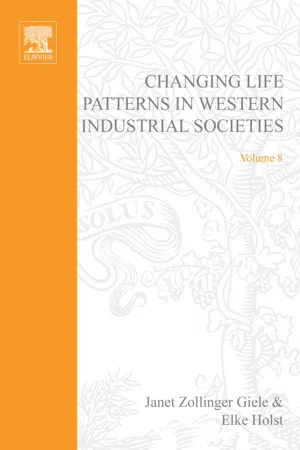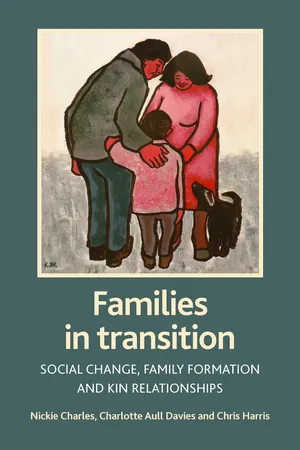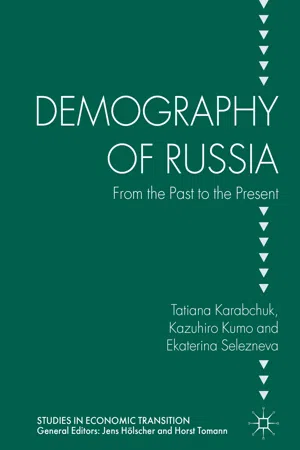Social Sciences
Changing Patterns of Divorce Sociology
"Changing Patterns of Divorce Sociology" refers to the study of how divorce rates, reasons for divorce, and the impact of divorce on individuals and society have evolved over time. This field of sociology examines the social, cultural, and economic factors that influence divorce trends, as well as the consequences of divorce for families, children, and communities.
Written by Perlego with AI-assistance
Related key terms
1 of 5
7 Key excerpts on "Changing Patterns of Divorce Sociology"
- eBook - PDF
- Liz Steel, Warren Kidd, Anne Brown(Authors)
- 2012(Publication Date)
- Bloomsbury Academic(Publisher)
Chapter 9 Changing Patterns of Marriage and Divorce By the end of this chapter you should: • understand contemporary patterns of marriage, divorce and remarriage • understand sociological reasons for divorce • be able to consider the potential futures that family life might have • be able to apply the contemporary ideas of postmodernity and reflexive modernity to issues of divorce • be able to apply the New Right perspective on divorce • be able to use sociological discussions to answer examination questions on divorce INTRODUCTION We often read in the popular tabloid press stories about the ‘crisis’ of modern family life. In many respects, these scare stories about family life are moral panics – they are sensationalist stories that encourage an exaggerated reaction of fear or panic in the public. In particular, such moral panics are frequently set off by members of the New Right, for whom single mothers, divorce and same-sex families threaten the existence of the nuclear family and, hence, the very fabric of ‘normal’ society. In other cases, domestic violence, and the abuse and neglect of children are highlighted for their shock value. This chapter examines sociological insights into divorce, and the changing patterns of marriage and remarriage in contemporary society. DIVORCE RATES AND THE CHANGING PATTERNS OF FAMILY LIFE Divorce increased markedly from the 1970s, became relatively stable in the 1990s and began to decline in the 2000s. Increasing or high divorce rates are a feature not just of British society (although Britain does have one of the highest divorce rates in Europe), but also of the United States and some countries in Eastern Europe. 159 - eBook - PDF
The Population of Singapore
(2nd Ecition)
- Saw Swee-Hock(Author)
- 2007(Publication Date)
- ISEAS Publishing(Publisher)
Divorce Trends and Patterns 127 7 Divorce Trends and Patterns In this chapter we will examine marital dissolution so as to complete our account of nuptiality trends and patterns. Divorce, the final outcome of irreconcilable marital discord, is seen to create social problems for the families concerned and for the community at large. It is also common to view a high divorce rate in a society like Singapore as a sign of diminishing family stability and weakening Asian cultural and social values. Not surprisingly, a rising trend in divorce incidence often generates considerable public concern and debate. From the demographic point of view, changes in the divorce incidence would have some impact on the level of fertility since a breakup in marriage will effectively reduce the period of reproductive life of the woman. The study of divorce in some countries is often handicapped by a paucity of statistics owing to the absence of an ongoing system of registering divorce cases and compiling statistics from such cases. Though records of divorce cases have been kept by the relevant authorities in Singapore, it was not until the early eighties that the Department of Statistics launched a project to compile divorce statistics on a regular basis. Two separate sets of divorce statistics are compiled nowadays: Muslim divorce statistics from the register of divorces administered by the Shariah Court, and non-Muslim divorce statistics from the records of divorce case files maintained by the High Court Registry. The two sets of annual statistics, along with some data for the years 1980–83, are made available in the annual publication entitled Statistics on Marriages and Divorces for the year 1984 onwards. 1 These statistics do convey an accurate picture of divorce trends and patterns in Singapore since marriages and their dissolution are effected within the legal framework of the country; marriages and divorces by consensus outside the law are not legally recognised. 127 - eBook - PDF
- Saw Swee-Hock(Author)
- 2012(Publication Date)
- ISEAS Publishing(Publisher)
127 7 Divorce Trends and Patterns In this chapter we will examine marital dissolution so as to complete our account of nuptiality trends and patterns. Divorce, the final outcome of irreconcilable marital discord, is seen to create social problems for the families concerned and for the community at large. It is also common to view a high divorce rate in a society like Singapore as a sign of diminishing family stability and weakening Asian cultural and social values. Not surprisingly, a rising trend in divorce incidence often generates considerable public concern and debate. From the demographic point of view, changes in the divorce incidence would have some impact on the level of fertility since a breakup in marriage will effectively reduce the period of reproductive life of the woman. The study of divorce in some countries is often handicapped by a paucity of statistics owing to the absence of an ongoing system of registering divorce cases and compiling statistics from such cases. Though records of divorce cases have been kept by the relevant authorities in Singapore, it was not until the early eighties that the Department of Statistics launched a project to compile divorce statistics on a regular basis. Two separate sets of divorce statistics are compiled nowadays: Muslim divorce statistics from the register of divorces administered by the Shariah Court, and non-Muslim divorce statistics from the records of divorce case files maintained by the Family Court Registry. The two sets of annual statistics, along with some data for the years 1980–83, are made available in the annual publication entitled Statistics on Marriages and Divorces for the year 1984 onwards. 1 These statistics do convey an accurate picture of divorce trends and patterns in Singapore since marriages and their dissolution are effected within the legal framework of the country; marriages and divorces by consensus outside the law are not legally recognised. - eBook - PDF
Families in Converging Europe
A Comparison of Forms, Structures and Ideals
- E. Oinonen(Author)
- 2008(Publication Date)
- Palgrave Macmillan(Publisher)
Increasing legal recognition of ‘untraditional’ living arrange- ments and the relaxation of divorce laws as well as the development of the welfare state are sometimes claimed to undermine, or even crumble away, the family’s role as the bedrock of society. Another line of deliberation and debate evoked by family-change moves on a more macro-level trying to understand what it is in a soci- ety that might cause change in the family. Individuals and families do not live in a vacuum. Economic, political, legal and cultural contexts and circumstances and their shifts and changes influence both individ- uals’ familial behaviour and the societal conception of the family and what it ought to be. Furthermore, it is not only national economy, pol- itics and laws that lay down the terms of social circumstances. The processes of globalization and European integration set economic, polit- ical and legal conditions that are reflected in the societal reality of the member states. The demographic statistics presented above depict individuals’ family-related choices and decisions in European societies, on average. In order to find possible explanations for the common trends and characteristics of different societies or clusters of societies, we need to consider the average behaviour of people within a wider context (Lewis, 2001; Oinonen and Alestalo, 2006). 28 Families in Converging Europe - Janet Zollinger Giele, Elke Holst(Authors)
- 2003(Publication Date)
- JAI Press(Publisher)
Similarly, there is a gap between private needs and public willingness to provide social support. Changing Life Patterns in Western Industrial Societies Advances in Life Course Research, Volume 8, 3–22 Copyright © 2004 by Elsevier Ltd. All rights of reproduction in any form reserved ISSN: 1040-2608/doi:10.1016/S1040-2608(03)08001-8 3 4 JANET ZOLLINGER GIELE AND ELKE HOLST The purpose of this chapter is to show the underlying order in these changes and to suggest the causes of widespread shifts in time use, life patterns, social institutions, and culture that are described in the rest of this book. We first present a theory of how social systems adapt to change over time that is based on the work of sociologist Talcott Parsons (1966) on societal evolution. We then build on the insights of Miriam Johnson (1989) who applied Parsons’ insights to the contemporary revolution in gender roles. THE PROCESS OF EVOLUTIONARY SOCIAL CHANGE As Darwin explained in the Origin of the Species , survival of a species depends on effective adaptation to the environment and to changing circumstances. So also in the social sciences there is broad agreement that societies are able to survive over the long-term only if they continue to meet basic needs of food production, procreation, internal coordination, and protection from enemies. In his theory of societal evolution Parsons (1966) outlined the basic types of structural change that have to occur when an old pattern of adaptation is rendered ineffective by changing external or internal circumstances. The key dynamic is structural differentiation in which an established social unit that was effective in the past must break into several specialized units in order to meet new challenges. Such differentiation is characteristic of the modernization process and usually results in a more efficient and complex social organization in which the units become organically interdependent.- eBook - PDF
Families in transition
Social change, family formation and kin relationships
- Charles, Nickie, Davies, Charlotte, Nickie Charles, Charlotte Davies(Authors)
- 2008(Publication Date)
- Policy Press(Publisher)
25 Changing societies TWO Changing societies Having explored the different ways in which social change and its effects on families have been theorised, in this chapter we turn our attention to the nature of the social change that has taken place between 1960 and the first decade of the 21st century. This provides a context for the exploration of patterns of family formation and kin relations that follows.We describe demographic, industrial and cultural change, looking particularly at the ways in which they have manifested themselves in Swansea, the setting for the research on which this book is based. We begin with an exploration of demographic change, as it is this which has led commentators to claim that ‘the family’ is in terminal decline. We then go on to look at the socioeconomic and cultural changes which, it is argued, have precipitated these changes. In the final part of the chapter we describe the research into families and social change which we carried out between 2001 and 2004 and consider some of the methodological difficulties that arise when conducting a restudy. Structural and cultural change in the UK Demographic change According to Therborn, the ‘second third of the twentieth century constitutes the Marriage Age in modern Western European history. Never before, … since at least mid-sixteenth-century England … had such a large proportion of the population married’ (Therborn, 2004, 163). Indeed the 1950s have been characterised as the heyday of the male-breadwinner family (Seccombe, 1993). Since then marriage has changed from being a normative expectation for women to being one option among many, divorce rates have risen, marriage rates have fallen and cohabitation has increased. Along with this the mean age at first marriage, which fell throughout the first half of the century and bottomed out in the early 1970s, has been rising, reaching 29.7 years for men and 28.4 years for women in mid-2001 (ONS, 2002a). - eBook - PDF
Demography of Russia
From the Past to the Present
- Tatiana Karabchuk, Kazuhiro Kumo, Ekaterina Selezneva(Authors)
- 2016(Publication Date)
- Palgrave Macmillan(Publisher)
126 T. Karabchuk 4.5 Empirical Studies on Divorce Determinants in Russia The attitude towards divorce has changed dramatically over the past decade. Many women who have experienced divorce, see it as a new phase in their life or as a kind of liberation (Voronina 2011). A divorced woman in today’s society is perceived quite differently than, for exam- ple, in Soviet times, when a divorce for a woman was a kind of stigma accompanied by public condemnation. A single mother is no longer a rare phenomenon, nor is she exposed to harsh criticism from modern Russian society (Demographic Modernization of Russia, 2006). The practice of childrearing by a single father is also no longer a surprise. Such a transformation is the result of the second demographic transition. This global liberalization of family relations explains the overall increase in the divorce rate; although it is still important to understand the other factors in contemporary divorce. The decision to divorce is influenced by various determinants, which are very specific to each individual family. However, there are common causes that account for family rupture, and they have been consistent over the past decade (Press release WCIOM 2007, 2011, 2013; Demoscope Weekly 2015). The factors of divorce can be divided into three groups (Churilov and Gutina 2014). The first group is connected to experienced events and previous conditions of life: parental or own experience of divorce; low level of welfare in the parental family. These factors explain the life cycle theory, according to which events once experienced affect future marriage and reproductive behavior patterns. But it is very dif- ficult to test this assumption on large longitudinal household surveys, as very detailed biographical information on each respondent is needed.
Index pages curate the most relevant extracts from our library of academic textbooks. They’ve been created using an in-house natural language model (NLM), each adding context and meaning to key research topics.

